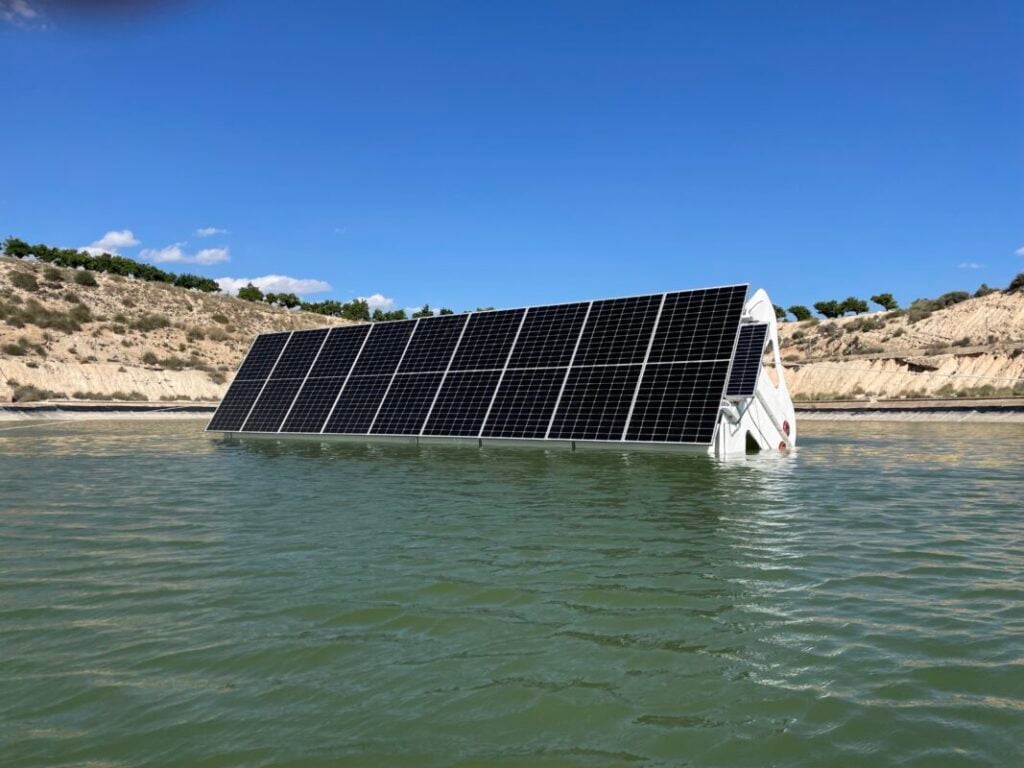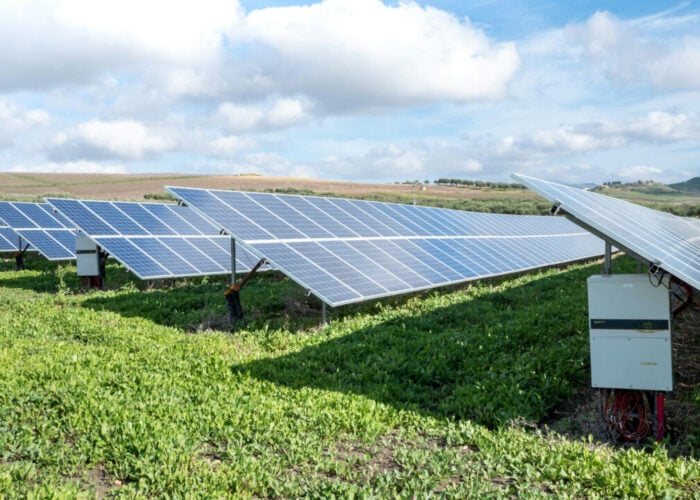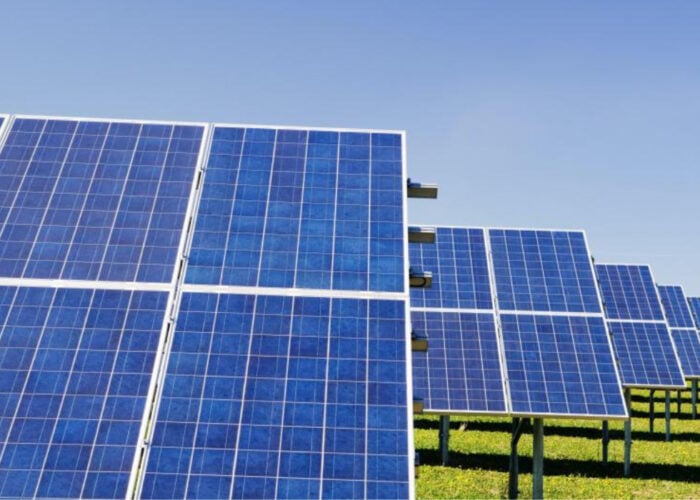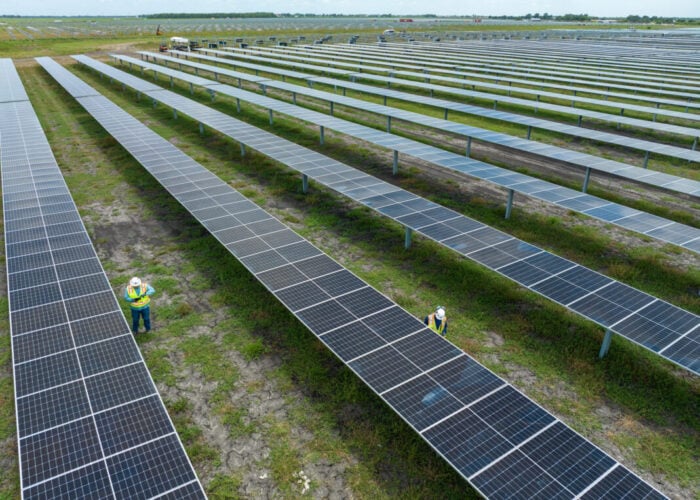
Last month, Spanish solar PV tracker manufacturer Soltec launched a new floating tracker, dubbed Flotus, designed for inland water bodies such as reservoirs and ponds.
Flotus features an east-west tracking system, similar to horizontal ground-based solar trackers, and an “advanced naval design” that Soltec claims enables it to withstand the rigours of being located on water.
Unlock unlimited access for 12 whole months of distinctive global analysis
Photovoltaics International is now included.
- Regular insight and analysis of the industry’s biggest developments
- In-depth interviews with the industry’s leading figures
- Unlimited digital access to the PV Tech Power journal catalogue
- Unlimited digital access to the Photovoltaics International journal catalogue
- Access to more than 1,000 technical papers
- Discounts on Solar Media’s portfolio of events, in-person and virtual
Design features
“Flotus’ naval design is inspired by the heeling of boats,” says Eduardo de San Nicolás, chief strategy and innovation officer of Soltec. “Instead of conceiving the arrays as a land-based solar PV design on floats, our point of departure is a 100% naval structure capable of supporting solar PV modules.”
This design approach can offer stability, robustness and reliability in the most challenging inland waters, according to the company.
Regarding its east-west tracking system, de San Nicolás says this is driven by the transfer of water in its central tank, which rolls the whole floating structure. The movement achieves angles of up to 60 degrees, enabling the system to capture sunlight during dusk and dawn.
“The movement is largely passive and performed without needing an engine, moving parts or batteries,” says de San Nicolás.
In addition to the enhanced tracking efficiency, modules installed on Flotus can benefit from the cooling effect of water evaporation which boosts power production. Tests conducted with Flotus at 38º latitude demonstrated yields that are over 20% higher than fixed-tilt floating systems and over 2% higher than ground-mounted trackers.
Potential safety issues
However, this innovation may spark concerns about its safety as using trackers on water bodies is a relatively new concept.
“Flotus counts on a very robust structure with three large longitudinal bodies that provide stability and motion. It can easily withstand wind gusts well beyond 50mph and waves over three feet while tracking,” de San Nicolás says.
He adds that the tracker can stow the modules in the event of wind reaching dangerous levels, acting as a defence strategy similar to that adopted by ground trackers.
“These features, along with the optimal placement and insulation of electrical and electronic components, make this technology very safe,” de San Nicolás adds.
Deploying floating solar trackers could impact the environment. For example, covering water surfaces for a long period of time could affect aquatic ecosystems, where sunlight plays an important role.
However, Flotus’ tracker rows are separated by 16-foot aisles, ensuring large spaces for sunlight penetration across the PV plant. Therefore, this could lower the risk of impacting aquatic ecosystems.
Application of Flotus
Flotus is applicable to inland water bodies, but it can also be used in sheltered sea waters with minor adaptations, according to de San Nicolás. In the next few years, Soltec will continue to focus on inland water bodies as this market sector will offer more opportunities.
“Flotus is especially profitable when used in hydropower plants. In combination with the electrical infrastructure of hydropower reservoirs, the tracker can maximise hydropower generation when the reservoir level is low.
“It also works to balance the grid as it allows for pumping water upstream from lower reservoirs. When needed, stored water can be transferred downstream to produce electricity for the grid,” says de San Nicolás.
Future deployment
The levelised cost of electricity (LCOE) of Flotus is 2% lower than fixed-tilt floating systems, according to Soltec. Looking ahead, de San Nicolás says Soltec will optimise all components to make the tracker “even more competitive”, tapping into the opportunities in markets where ground-mounted trackers are dominant.
Soltec’s current priority markets are in America and Europe. However, floating solar PV projects (FPV) are in a very early stage in the US and most of Europe.
“The main obstacles are the lack of awareness about this technology and legislation related to public water domains,” says de San Nicolás.
Previously, PV Tech reported that the global floating solar market will surpass 6GW by 2031, with China, India and Southeast Asia set to deploy the lion’s share. Speaking of the difference between European countries and their Asian counterparts, Daniel Garasa Sagardoy, research analyst of power and renewables at Wood Mackenzie, says that permitting procedures and environmental concerns were the major barriers to the development of floating solar.
However, de San Nicolás says this is already changing in many countries, and larger PV plants are achieving ready-to-build permits worldwide.
Recently, Spain has passed a regulation regarding the installation of FPV on publicly or state-owned reservoirs in the country. Mesotrophic waters, those considered ‘clear water’, will have a maximum capacity of 5% of the reservoir’s surface; however this increases to 15% for eutrophic waters, those with a high biological presence.
Solar PV plants will not be installed in lakes, ponds or other water surfaces that have not been altered or are not considered artificial. Awarded licences are to be temporary, lasting no more than 25 years, either through the proposal of companies or through public auctions.
Looking ahead, Soltec will prioritise the US and European markets where Soltec is currently operating. De San Nicolás is also optimistic about these markets’ potential as the FPV sector will “grow rapidly in the coming years”.
Last year’s Wood MacKenzie report said that although China, India and Indonesia would make up almost 70% of the world’s FPV capacity by 2031, 15 countries and regions are set to surpass 500MW of installed capacity by that time and that nine of the top ten FPV markets would be in Asia.
With this potential, de San Nicolás says Soltec would not rule out expanding its activities to Asia, but the company needs to find the right partner in the region.







